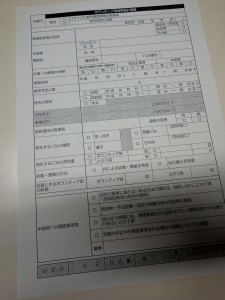If you’re finding yourself longing for some western dish that is generally not available in Japanese restaurants, perhaps something your mom made when you were child, your only option may be to cook the dish yourself. Maybe this article will help you find the necessary ingredients? If you don’t find your answer here, feel free to leave a comment.
Supermarkets
First of all, if you can’t find what you’re looking for, try a bigger supermarket. If you are in Tokyo, you may have some trouble finding a big one, so here’s a list of supermarket chains that tend to have bigger stores:
- イトーヨーカドー (Ito Yokado)
- マルエツ (Maruetsu)
- ライフ (Life)
- ダイエー (Daiei)
- マックスバリュー (Max Value)
In addition, these two places have a strong selection of imported goods and are partially geared towards people buying in bulk:
- 肉のハナマサ (Niku no Hanamasa)
- 業務スーパー (Gyoumu Suupaa / Super / Supermarket)
Here are some well-equipped import stores:
- 成城石井 (Seijou-Ishii)
- Kaldi Coffee Farm (Weird name, but just a normal store)
- Lapin (local chain in Matsue, Shimane) has a good selection of imported goods
Stocks
This is a very popular stock for western foods: Ajinomoto Consomme. According to the ingredients it includes both chicken and beef extracts. There are other stocks available, including chicken, beef, and vegetable stocks, but not all supermarkets have all of these. Beef stock feels a bit less common, and vegetable stock almost rare.
Milk products
Milk products are quite pricy in Japan. You can get milk, yoghurt, cream, sour cream, and various types of cheese at most supermarkets. Butter is available, but often sold out. (Reportedly, especially before February 14.) The types of cheese available at supermarkets are as follows:
- Shredded cheese (practically everywhere — usually imported and consisting of cheddar, gouda, mozzarella) (unless you buy in bulk, expect to pay 100-200 JPY per 100 g)
- Those wrapped square processed cheese slices (practically everywhere) (about 200 yen for a pack of ~10 slices)
 Cream cheese:
Cream cheese:
- Philadelphia (available at most supermarkets) (about 400 yen for a 200 g pack) (you’ll sometimes find a cheaper, very similar product by メグミルク (Meg-Milk))
- Camembert* (available at most supermarkets)
- Cottage cheese (available at some supermarkets)
- Mascarpone* (available at some supermarkets)
* Not sure if these count as cream cheeses
- Mozzarella (round balls) (available at many supermarkets, but about 300 JPY per 100 g)
- Parmesan cheese (available at most supermarkets in powder form)
- Cheese in tiny portions to be eaten as a tsumami (can be quite high-quality)
- Cheese in small portions to be eaten as a snack (I recommend さけるチーズ (sakeru chiizu))
Bigger supermarkets may sell packets of non-sliced gouda and/or cheddar. For other kinds of cheese, you may have to try an import store or the basement floor of an expensive department store. (Note: you’ll pay about 1000 JPY per 100 g of cheese at the department store.)
By the way, here are the reasons butter is often hard to get (from what I’ve gathered):
- Milk products are made according to a priority production system:
milk, cream > cheese, yoghurt > butter
- Low-fat milk isn’t very popular in Japan
Condiments
Ketchup, mayonnaise and mustard are available, but Japanese mayonnaise is made differently and tastes a bit different. You can get western-style mayonnaise at import shops like 成城石井 (Seijou-Ishii). There are three types of mustard that are widely available in Japan: Japanese mustard (からし, karashi), French Dijon mustard, American yellow mustard. Karashi is similar to wasabi or horseradish in pungency. Ketchup appears to be about the same as everywhere else.
As for vinegar, you will find at least wine vinegar (red and white) and balsamic vinegar. I’ve never seen malt vinegar in shops, but it appears to be available on Amazon.
The most common types of vinegar are 穀物酢 (kokumotsu-su, grain vinegar) and rice vinegar. Grain vinegar is pretty cheap, but I wouldn’t recommend buying it over the slightly more expensive rice vinegar if you intend to use it in food. (Of course, our mileage may vary.)
Oil
- Olive oil is widely available
- Vegetable oil is widely available (often rapeseed or sunflower)
- Flaxseed oil (亜麻仁油) is usually available in bigger supermarkets (very pricy though)
Aromatic vegetables
Onions, scallions, leek, garlic, green peppers, and carrots are all widely available. Celery stalks and leaves are often available, but I’ve never seen celery root. Shallots are rare.
Other vegetables
- Widely available: broccoli, spinach, cabbage (red cabbage isn’t that widely available), lettuce, tomatoes, eggplant, cucumbers, bell peppers, radish (daikon)
- If you’re into pumpkins/squashes, Japan has kabocha: green outside, orange inside, both parts being edible. That’s the only type of squash that I’ve seen, but very widely available.
- Slightly less common: cauliflower (expensive (300 JPY for a small head) in Tokyo, cheap (150+ JPY for a larger head) in Shimane), zucchini (usually not available in winter)
- Usually not available in supermarkets: Brussels sprout, kale (I’ve seen both though)
Everything else may be difficult to find.
Canned vegetables
The Gyoumu Supermarket generally shines in the canned goods category.
- Canned tomatoes are widely available, usually for less than 100 JPY
- Canned corn is widely available (also the only item in this category that has a good chance of not being imported)
- Canned/glass-jarred olives are often available at supermarkets. You can get them cheapest at the Gyoumu Supermarket.
- Canned (white) asparagus is often available in supermarkets. Green asparagus is often available fresh, especially in spring. Fresh white asparagus is available sometimes, but a bit pricey
- Canned/glass-jarred pickled cucumbers (gherkin) are available at many supermarkets, but pretty pricey. Try the Gyoumu Supermarket
Legumes (Beans)
The Gyoumu Supermarket shines here, too.
- Canned kidney beans are available in most supermarkets. Some supermarkets may have dried beans. Definitely available at the Gyoumu Supermarket
- Canned chickpeas are slightly less common than kidney beans, but still reasonably available. Definitely available at the Gyoumu Supermarket
- Lentils are pretty rare. Try Seijou-Ishii and similar supermarkets. Not available at the Gyoumu Supermarket, as far as I know
- Broad beans are sometimes used in Japanese cooking, and thus sometimes available fresh. Otherwise they may be available dried
- Normal green beans (いんげん, the long ones) are available frozen at the Gyoumu Supermarket, and sometimes fresh
- Regular peas are available frozen
Fresh herbs
Most supermarkets with a non-tiny vegetable section will have parsley. If it’s a bigger supermarket, they will probably have other fresh herbs. Basil is the most common. You’ll often find rosemary and sage.
- Parsley (commonly available)
- Basil (reasonably commonly available)
- Mint (if basil is available, mint is probably available too)
- Rosemary, sage, chervil (available in some stores)
Everything else may be difficult to find, but have a look at SB’s lineup of fresh herbs.
Non-fresh herbs and spices
Most herbs and spices that I’m familiar with are mostly available.
Here are some herbs that might be hard to find in stores: caraway, non-generic varieties of paprika, marjoram. (Try Amazon if you can’t find your favorite herb or spice in the stores.)
Most stores sell herbs and spices in tiny bottles containing 3-10 g of actual product. In the case of paprika, you’re likely to use up the entire bottle for a single meal. If you regularly use a certain herb or spice a lot, you may be better off buying in bulk from Amazon.
For curry mixes, you usually have two choices: Garam Masala and a typical mix that produces the flavor of Japanese curry.
Mushrooms
- Common mushroom (commonly available, but expensive, though much cheaper here in Shimane)
- Oyster mushroom (ヒラタケ, hiratake) (commonly available, and not quite as expensive) (also used in Japanese cooking) (never used it)
- Hen-of-the-woods (舞茸, maitake) (commonly used in Japanese cooking and therefore commonly available and cheap; works well in many western dishes)
- Porcini are only available in dried packs, and most supermarkets don’t seem to have them
Meat
- Beef is expensive, and often imported from the US or Australia
- Pork feels neither expensive nor cheap, and is usually Japanese produce
- Chicken feels very cheap, and is usually Japanese produce
You can get minced meat of all of the above. Occasionally, you’ll find a supermarket that doesn’t have minced beef. (This seems to be a more common occurrence in Shimane.) The most common type of minced meat is a mix between beef and pork.
Most supermarkets will also sell steaks, but you’ll probably pay 1000 JPY or more for a decent-sized one.
Wiener sausages are available at virtually all supermarkets. Most supermarkets will have a small selection of non-wiener sausages. If you want to eat decent sausages, I recommend the こだわり生フランク (kodawari nama-furanku) from the Gyoumu Supermarket. I think these are probably among the best sausages you can buy in Japan.
Other types of meat may be hard to find, but some supermarkets have mutton now.
Fish
Lots of fish in Japan.
Smoked salmon, canned tuna and canned anchovy are available. Herring is available, but soused herring isn’t. (Justification for this factoid: I know a Japanese guy who loves soused herring.)
Nuts
All nuts that I’m familiar with, except hazelnuts, are available at most supermarkets, though (unless they’re peanuts) usually quite expensive.
Flour
Most supermarkets have only two types of flour: 薄力粉 (hakurikiko) and 強力粉 (kyourikiko). Hakurikiko is cheaper, and is usually used for cakes, cookies, okonomiyaki, and tenpura. Kyourikiko is used for bread. Both are non-whole-wheat. To get whole-wheat, rye, and other types of flour, go to Seijou-Ishii or similar import stores.
Carbs
- Japanese rice works just fine in western dishes (including risotto)
- Potatoes are expensive. They’re more used as a vegetable, rather than a source of carbs in Japanese cooking
- Frozen french fries are available. You can get them much cheaper at the Gyoumu Supermarket than at most other places
- Pasta is available, but I have a feeling that the cheap stuff tastes a bit odd. ~100 yen per 250 g seems to get you good quality. (I kind of have a feeling that low-quality pasta tends to get some unwanted flavor from its packaging.) Small supermarkets often only have spaghetti or fast-cooking pasta
- Cornflakes are widely available
- Oatmeal is starting to appear in store shelves
- I’ve seen couscous at Kaldi Coffee Farm and Lapin in Matsue
- Bread is explained in the next section
Bread
Perhaps we’ve come to the most disappointing part of this article. (Note that I’m not trying to be objective in this paragraph.)
White bread that you would toast before eating is ubiquitous. Other kinds of bread will be harder to find. Bread that contains a small percentage of rye is becoming more common these days, but bread with a significant ratio of rye, let alone pure rye bread, is exceedingly rare. There are bakeries in Japan, but if you go into one, you’ll often find that filled bread is way more common than “naked” bread. If you’re lucky, you’ll find something without any fillings, but most will be white bread: baguettes, croissants. Many bakeries will sell something called パン・ド・カンパーニュ (Pain de campagne), which may be quite passable. (It uses sourdough.) If you don’t have an obvious bakery in your vicinity, try some of the chains:
- Anderson http://www.andersen.co.jp/ is quite okay.
- Linde (http://www.lindtraud.com/) in Tokyo has pretty good bread.
- The best bread I’ve had in Japan was from Maison Kayser in Sunshine City in Ikebukuro, Tokyo. However, when I went to check them out (on May 28, 2017), they didn’t have any dark bread for some reason. :(
- High-quality supermarkets like Seijou-Ishii usually have decent bread too.
By the way, this raisin and walnut stone oven bread tastes very nice and is possibly available at many Aeon stores.
So what to put on your bread? Japan doesn’t have a large selection of spreads, but peanut butter, nutella, (at least) strawberry jam, cheese (see above), and some types of meat are available at most supermarkets. In supermarkets, you’ll often see small Real salami is pretty expensive. Seijou-Ishii and the Gyoumu Supermarket usually sell bruschetta spreads.
 You’ll often see peanut butter and strawberry jam being sold in small containers for about 120 JPY that look like in the image pictured here on the right. This stuff, especially the peanut butter, tastes pretty bad, in my opinion. The cheap price may entice you to buy this, but don’t say I didn’t warn you. :p
You’ll often see peanut butter and strawberry jam being sold in small containers for about 120 JPY that look like in the image pictured here on the right. This stuff, especially the peanut butter, tastes pretty bad, in my opinion. The cheap price may entice you to buy this, but don’t say I didn’t warn you. :p



 Cream cheese:
Cream cheese:
 You’ll often see peanut butter and strawberry jam being sold in small containers for about 120 JPY that look like in the image pictured here on the right. This stuff, especially the peanut butter, tastes pretty bad, in my opinion. The cheap price may entice you to buy this, but don’t say I didn’t warn you. :p
You’ll often see peanut butter and strawberry jam being sold in small containers for about 120 JPY that look like in the image pictured here on the right. This stuff, especially the peanut butter, tastes pretty bad, in my opinion. The cheap price may entice you to buy this, but don’t say I didn’t warn you. :p
